Module 3: Staff Empowerment
AHRQ Safety Program for Long-Term Care: HAIs/CAUTI
Slide 1: Module 3: Staff Empowerment

Slide 2: Objectives

- Cite staff empowerment concepts.
- Discuss how staff empowerment contributes to a culture of resident safety, leading to improved outcomes and quality of life.
- Illustrate three ways to increase staff empowerment.
- Explain how to address and overcome challenges to staff empowerment.
Slide 3: What Is Staff Empowerment?

- Ability to independently make decisions.
- "Access to support, resources, information, and opportunities to learn and grow".1
Slide 4: Organizational Factors for Staff Empowerment2-4

- Structures for advancement opportunities.
- Awareness of staff contributions.
- Access to resources, information, and support.
Image: Staff looking at a table
2. Brannon D, Mor V. Nurse aide empowerment strategies and staff stability: Effects on nursing home resident outcomes. The Gerontologist. 2005;45(3):309-317.
3. Bowers N, Nolet K, Roberts E, et al. Implementing Change in Long-Term Care: A Practical Guide to Transformation. University of Wisconsin–Madison, School of Nursing; 2007.
4. Cready C, Yeatts D, Gosdin M, et al. CNA empowerment: Effects On Job Performance And Work Attitudes. Journal of Gerontological Nursing. 2008;34(3):26-35.
Slide 5: Staff Empowerment Assessment Tools3,5

HHS Report - Measuring Long-Term Care Work: A Guide to Selected Instruments to Examine Direct Care Worker Experiences and Outcomes
- Conditions for Work Effectiveness Questionnaire.
- Perception of Empowerment Instrument (PEI).
- Psychological Empowerment Instrument.
- Yeatts and Cready Dimensions of Empowerment Measure.
3. Bowers N, Nolet K, Roberts E, et al. Implementing Change in Long-Term Care: A Practical Guide to Transformation. University of Wisconsin–Madison, School of Nursing; 2007.
5. Harris-Kojetin L, Brannon D, Barry T, et al. Measuring Long-Term Care Work: A Guide to Selected Instruments To Examine Direct Care Worker Experiences and Outcomes. Washington, D.C.: U.S. Department of Health & Human Services, U.S. Department of Labor; 2005.
Slide 6: Psychological Empowerment Instrument5

Sample questions for measuring competence:
How strongly do you agree or disagree with these statements?
- I am confident about my ability to do my job.
- I am self-assured about my capability to perform my work.
- I have mastered the skills necessary for my job.
5. Harris-Kojetin L, Brannon D, Barry T, et al. Measuring Long-Term Care Work: A Guide to Selected Instruments To Examine Direct Care Worker Experiences and Outcomes. Washington, D.C.: U.S. Department of Health & Human Services, U.S. Department of Labor; 2005.
Slide 7: Why is Staff Empowerment Important?5,6

- Higher staff satisfaction.
- Lower turnover.
- Improved quality of care for residents.
Image: Staff with a resident in a wheelchair
5. Harris-Kojetin L, Brannon D, Barry T, et al. Measuring Long-Term Care Work: A Guide to Selected Instruments To Examine Direct Care Worker Experiences and Outcomes. Washington, D.C.: U.S. Department of Health & Human Services, U.S. Department of Labor; 2005.
6. Kolus K. Mather Pavilion – Staff Empowerment Yields Quality Improvement. Long-Term Living. 2010;59(9):20.
Slide 8: Relationship Between Resident Quality of Life and Staff Empowerment7

Image: Increased staff empowerment leads to increased job satisfaction and lower job turnover, which in turn leads to increased resident satisfaction and perception of care, resulting in a higher quality of care overall.
7. Hamann DJ. Does Empowering Resident Families or Nursing Home Employees in Decision Making Improve Service Quality? Journal of Applied Gerontology. 2014;33(5):603-23
Slide 9: Importance of Empowering Nursing Staff4,7

- Frontline providers.
- Increased flow of information.
- Resident advocates.
Image: Staff walking
4. Cready C, Yeatts D, Gosdin M, et al. CNA empowerment: Effects On Job Performance And Work Attitudes. Journal of Gerontological Nursing. 2008;34(3):26-35.
7. Hamann DJ. Does Empowering Resident Families or Nursing Home Employees in Decision Making Improve Service Quality? Journal of Applied Gerontology. 2014;33(5):603-23
Slide 10: Characteristics of an Empowered Frontline Staff

- Curiosity.
- Interest in improvement.
- Knowledge of nursing home resources and infrastructure.
Image: Nursing reviewing charts
Slide 11: Curiosity

- Understand changes and the reasoning behind them.
- Increase their knowledge about clinical care areas.
- Have numerous opportunities to learn about how the organization operates and how resources are allocated.
Slide 12: Interest in Improvement
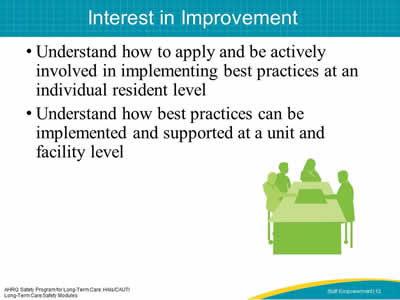
- Understand how to apply and be actively involved in implementing best practices at an individual resident level.
- Understand how best practices can be implemented and supported at a unit and facility level.
Image: Staff at a table
Slide 13: Knowledge of Nursing Home Resources and Infrastructure
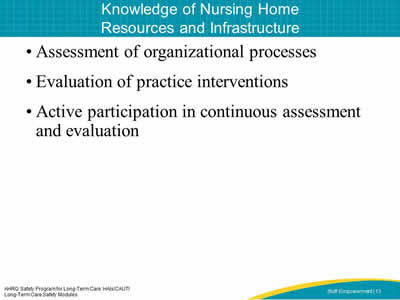
- Assessment of organizational processes.
- Evaluation of practice interventions.
- Active participation in continuous assessment and evaluation.
Slide 14: What Builds Staff Empowerment?
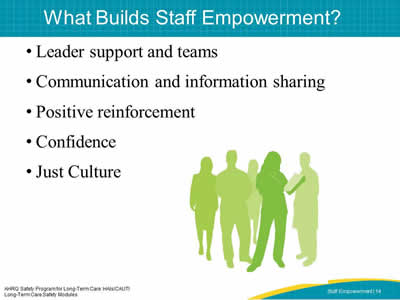
- Leader support and teams.
- Communication and information sharing.
- Positive reinforcement.
- Confidence.
- Just Culture.
Image: A group of staff
Slide 15: An Empowered Team

Image: Indicating a video on the slide
PLAY VIDEO:
Video 2.2: Enabling the Team
Slide 16: Leader Support and Teams2,4
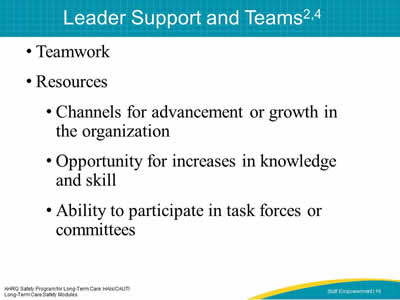
- Teamwork
- Resources
- Channels for advancement or growth in the organization.
- Opportunity for increases in knowledge and skill.
- Ability to participate in task forces or committees.
2. Brannon D, Mor V. Nurse aide empowerment strategies and staff stability: Effects on nursing home resident outcomes. The Gerontologist. 2005;45(3):309-317.
4. Cready C, Yeatts D, Gosdin M, et al. CNA empowerment: Effects On Job Performance And Work Attitudes. Journal of Gerontological Nursing. 2008;34(3):26-35.
Slide 17: Teamwork and Support
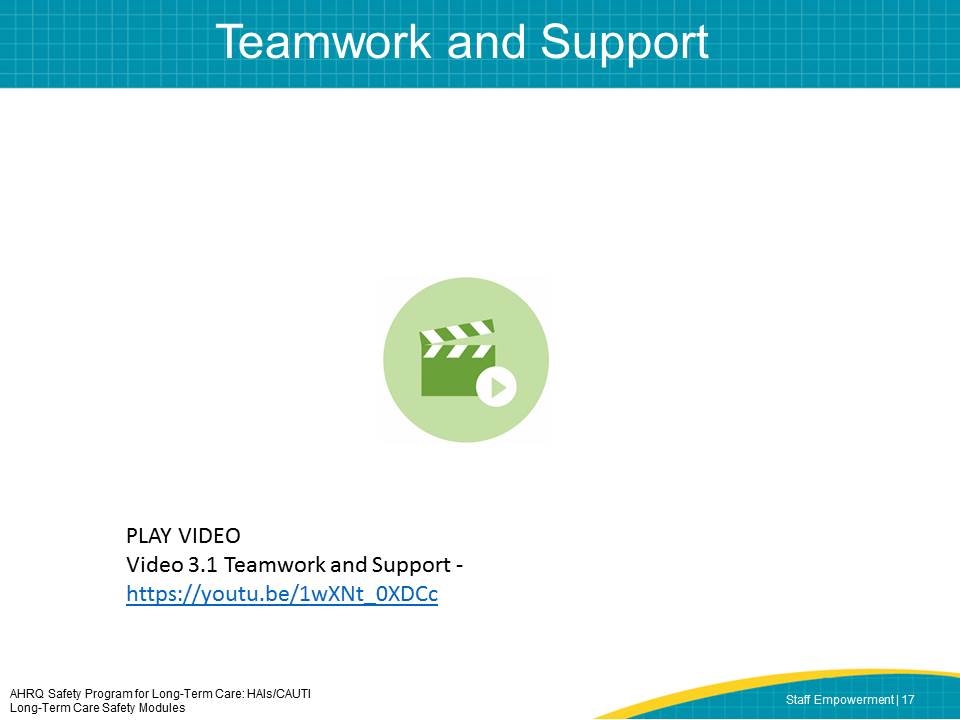
Image: Indicating a video on the slide
PLAY VIDEO
Video 3.1 Teamwork and Support
Slide 18: Communication and Information Sharing3
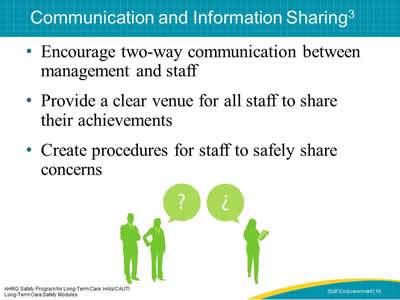
- Encourage two-way communication between management and staff.
- Provide a clear venue for all staff to share their achievements.
- Create procedures for staff to safely share concerns.
Image: Unclear communication between staff
3. Bowers N, Nolet K, Roberts E, et al. Implementing Change in Long-Term Care: A Practical Guide to Transformation. University of Wisconsin–Madison, School of Nursing; 2007.
Slide 19: Open Communication
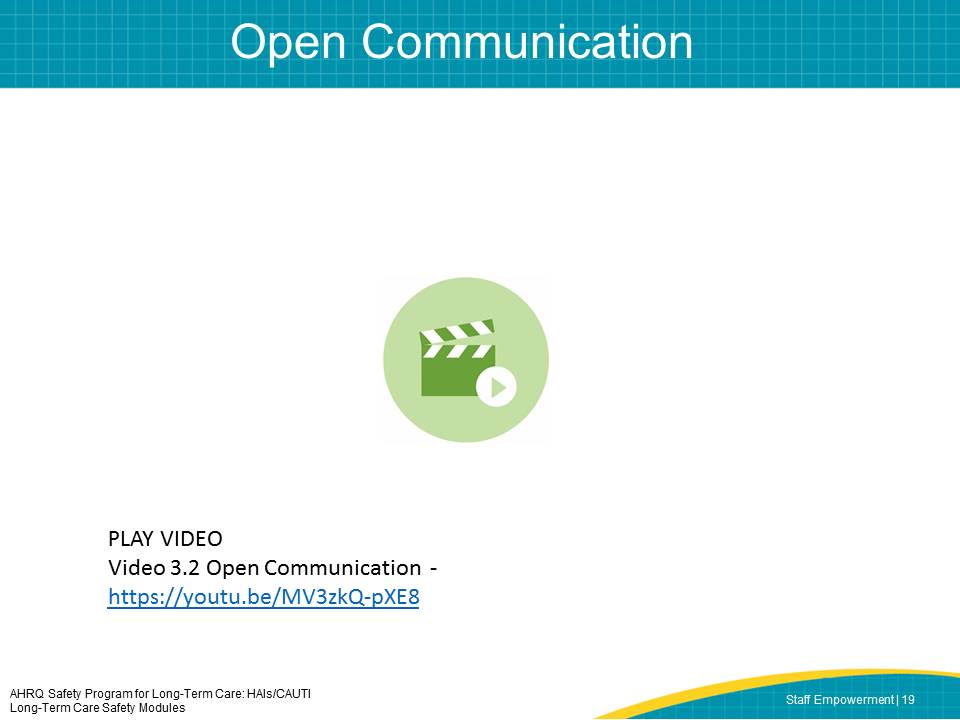
Image: Indicating a video on the slide
PLAY VIDEO
Video 3.2 Open Communication
Slide 20: Positive Reinforcement3
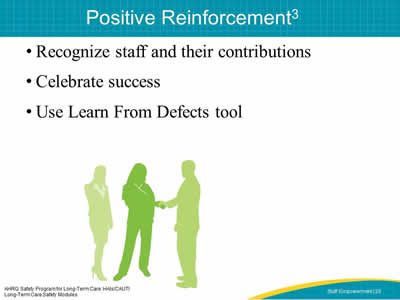
- Recognize staff and their contributions.
- Celebrate success.
- Use Learn From Defects tool.
Image: Staff shaking hands
3. Bowers N, Nolet K, Roberts E, et al. Implementing Change in Long-Term Care: A Practical Guide to Transformation. University of Wisconsin–Madison, School of Nursing; 2007.
Slide 21: Positive Reinforcement
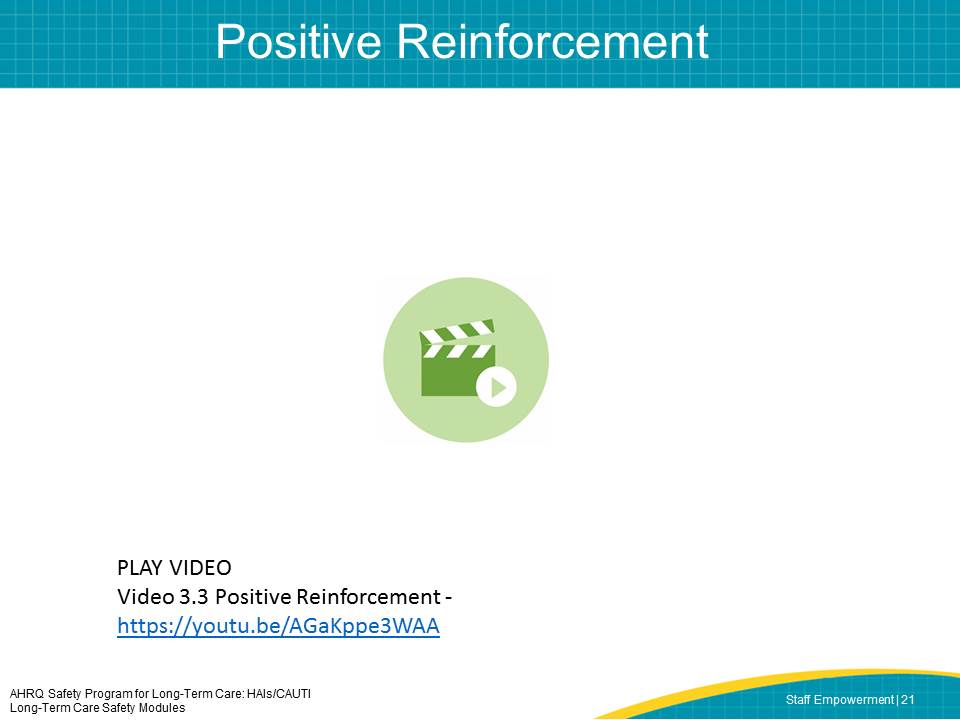
Image: Indicating a video on the slide
PLAY VIDEO
Video 3.3 Positive Reinforcement
Slide 22: Confidence9
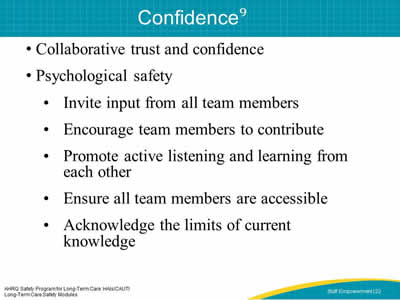
- Collaborative trust and confidence.
- Psychological safety
- Invite input from all team members.
- Encourage team members to contribute.
- Promote active listening and learning from each other.
- Ensure all team members are accessible.
- Acknowledge the limits of current knowledge.
9. CUSP Toolkit. Rockville, MD: Agency for Healthcare Research and Quality; December 2012.
Slide 23: Collaborative Trust and Confidence
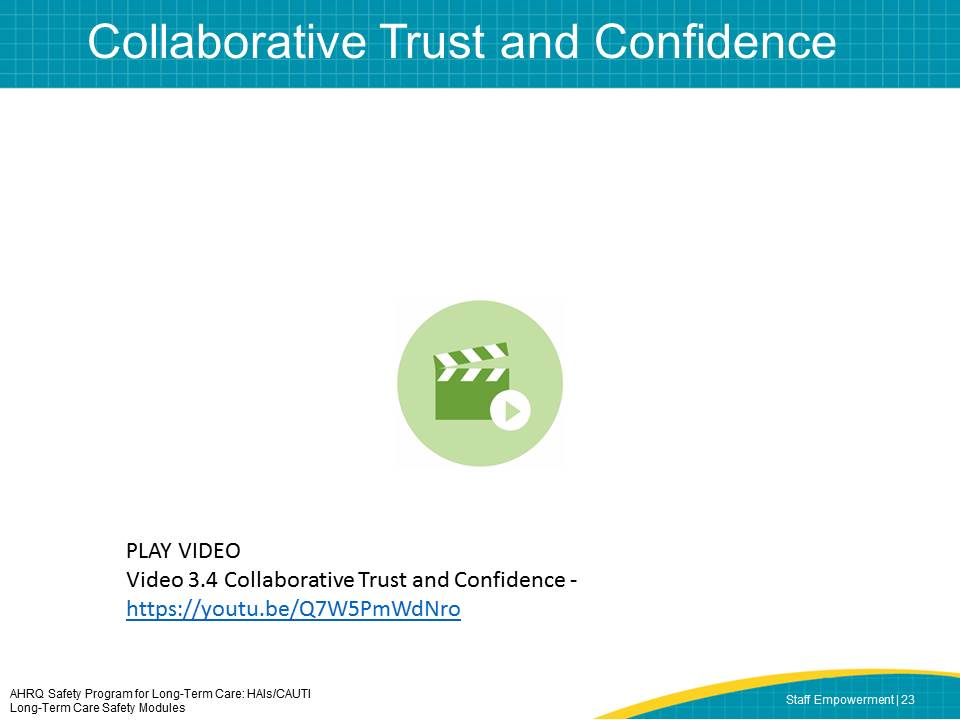
Image: Indicating a video on the slide
PLAY VIDEO
Video 3.4 Collaborative Trust and Confidence
Slide 24: Just Culture8,9
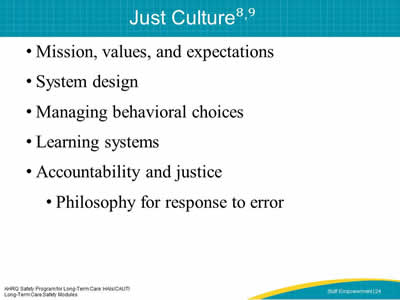
- Mission, values, and expectations.
- System design.
- Managing behavioral choices.
- Learning systems.
- Accountability and justice
- Philosophy for response to error.
8. Griffith S. Just Culture, Healthcare Services Overview. Outcome Engineering; 2012.
9. CUSP Toolkit. Rockville, MD: Agency for Healthcare Research and Quality; December 2012.
Slide 25: A Just Culture
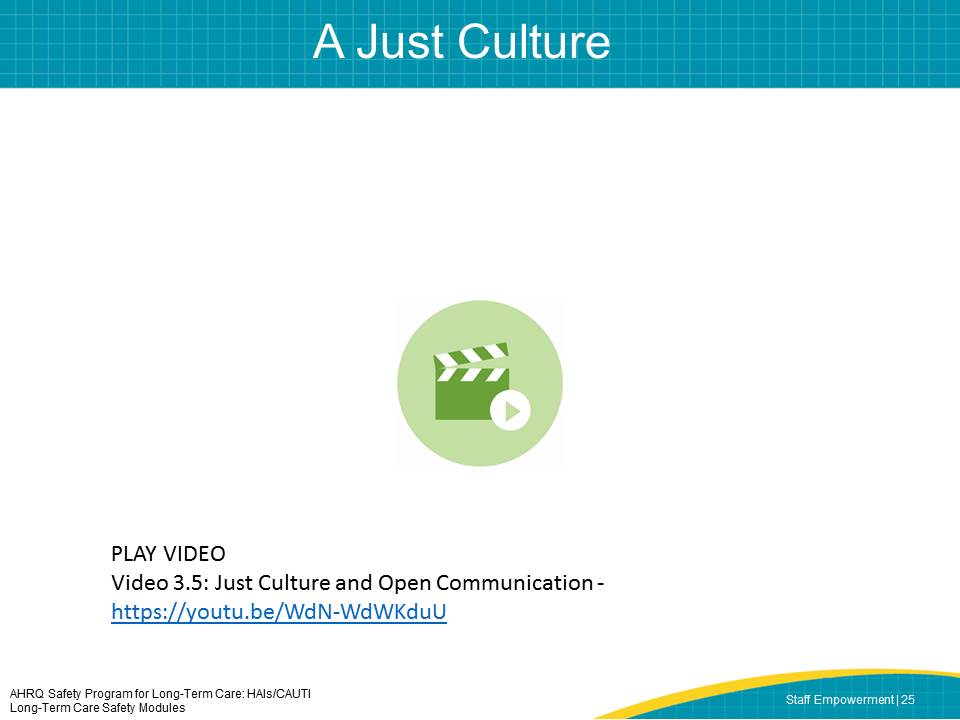
Image: Indicating a video on the slide
PLAY VIDEO
Video 3.5: Just Culture and Open Communication
Slide 26: Barriers to Staff Empowerment10
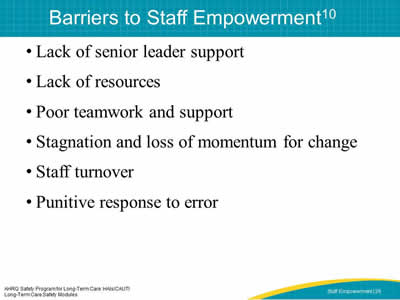
- Lack of senior leader support.
- Lack of resources.
- Poor teamwork and support.
- Stagnation and loss of momentum for change.
- Staff turnover.
- Punitive response to error.
10. TeamSTEPPS Long-Term Care Toolkit. Rockville, MD. Agency for Healthcare Research and Quality; October 2012.
Slide 27: Key Concepts Review
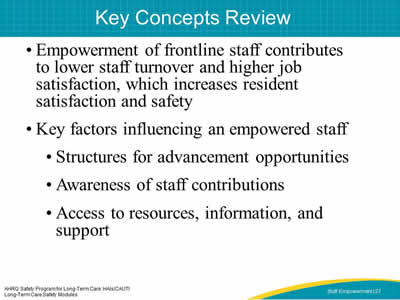
- Empowerment of frontline staff contributes to lower staff turnover and higher job satisfaction, which increases resident satisfaction and safety.
- Key factors influencing an empowered staff
- Structures for advancement opportunities.
- Awareness of staff contributions.
- Access to resources, information, and support.
Slide 28: References
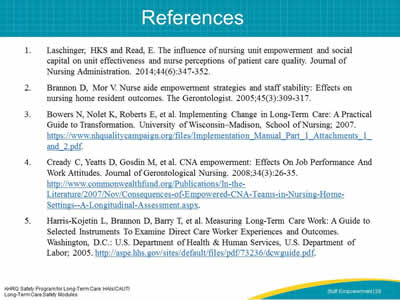
- Laschinger, HKS and Read, E. The influence of nursing unit empowerment and social capital on unit effectiveness and nurse perceptions of patient care quality. Journal of Nursing Administration. 2014;44(6):347-352.
- Brannon D, Mor V. Nurse aide empowerment strategies and staff stability: Effects on nursing home resident outcomes. The Gerontologist. 2005;45(3):309-317.
- Bowers N, Nolet K, Roberts E, et al. Implementing Change in Long-Term Care: A Practical Guide to Transformation. University of Wisconsin–Madison, School of Nursing; 2007.
- Cready C, Yeatts D, Gosdin M, et al. CNA empowerment: Effects On Job Performance And Work Attitudes. Journal of Gerontological Nursing. 2008;34(3):26-35.
- Harris-Kojetin L, Brannon D, Barry T, et al. Measuring Long-Term Care Work: A Guide to Selected Instruments To Examine Direct Care Worker Experiences and Outcomes. Washington, D.C.: U.S. Department of Health & Human Services, U.S. Department of Labor; 2005.
Slide 29: References
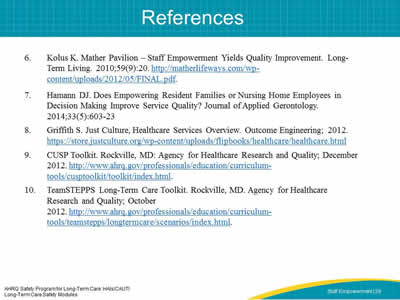
- Kolus K. Mather Pavilion – Staff Empowerment Yields Quality Improvement. Long-Term Living. 2010;59(9):20.
- Hamann DJ. Does Empowering Resident Families or Nursing Home Employees in Decision Making Improve Service Quality? Journal of Applied Gerontology. 2014;33(5):603-23
- Griffith S. Just Culture, Healthcare Services Overview. Outcome Engineering; 2012.
- CUSP Toolkit. Rockville, MD: Agency for Healthcare Research and Quality; December 2012.
- TeamSTEPPS Long-Term Care Toolkit. Rockville, MD. Agency for Healthcare Research and Quality; October 2012.



